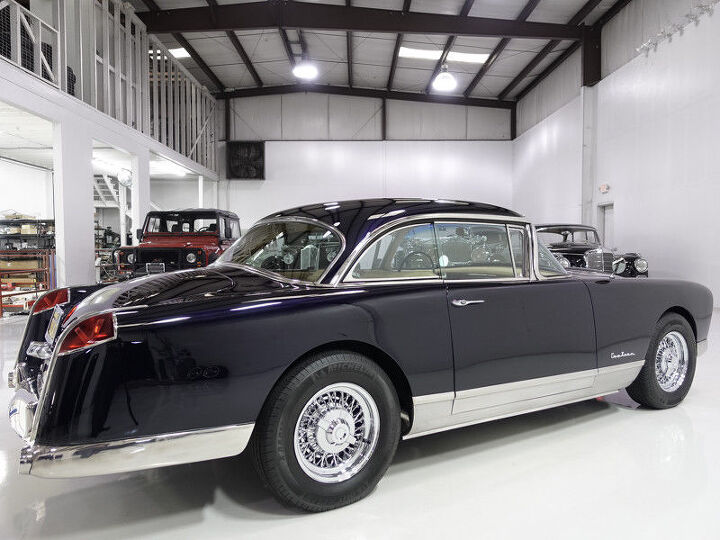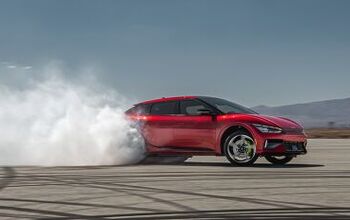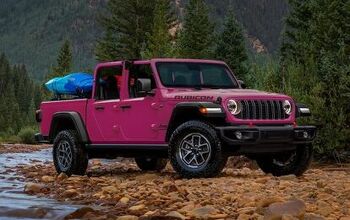Rare Rides: A 1957 Facel Vega Typhoon, for Luxurious People

As I was perusing the eBay listing for the Dual Ghia we previously featured in this series, another blue two-door classic appeared as a recommended listing at the bottom of the page. It’s from the same seller as the Ghia, and is remarkably similar in concept, execution, and customer.
Presenting the Facel Vega Typhoon, from 1957.
Facel started out in the steel business back in 1939, making pressed steel aircraft components and various pieces of steel furniture. Facel was created as a division of larger parent company Bronzavia, whose main business was producing military aircraft. The company’s first venture into the automotive realm occurred in 1945, as companies like Simca, Panhard, Delahaye, and Ford contracted with Facel to produce limited-run coupe bodies.
The end of World War II, combined with technological developments in car production lead to lower demand for Facel’s two main skillsets: aircraft parts and coachbuilt cars. Facel decided it was time to enter the luxury car game and make cars of their own. A luxury car division was started in 1948, as the company continued to develop some bodies for other manufacturers. Notably Facel produced the body for the French market Ford Comète, which it would later develop into the Vega we see here.
The all-new Vega model made its public debut in 1954. Originally using 4.5-liter DeSoto Hemi engines, 1956 saw a replacement 5.4-liter Chrysler engine under the long hood. At the time France imposed a car tax according to horsepower figures, which ensured 77% of all Vegas would be exported to other countries. All Vegas were two-door pillar-less models, in either convertible or hardtop format.
Much like the Dual Ghia, the Vega was aimed squarely at the luxury customer, with a Connolly leather interior trimmed with a high level of workmanship. The aircraft-inspired dashboard also featured a padded center console, and was one of the first vehicles to implement such a feature over the transmission tunnel.
Continual improvement and evolution of the Vega occurred each year, bringing us this FV4 Typhoon model. As the model was developed, generational numbers were added after its model abbreviation “FV.” The Typhoon script on the lower fender is in reference to Chrysler’s 5.8-liter Typhoon V8 under the hood. Today’s example is a bit of a crossover – a 1957 chassis, and an engine not available until 1958. The seller notes it was not registered until the 1958 calendar year. Such was the way with small manufacturers in the 1950s.
Continual improvement of the Vega ended when the Vega II debuted for 1962. By that time the company branched out into other models of two- and four-door guise. However, subsequent models utilized a more mass-market approach to manufacturing, and quality concerns quickly arose. Funding faltered, production slowed, and Facel was defunct by 1964. Parent company Bronzavia is alive and well today, and still produces high-tech airplane equipment.
Today’s 1957/58 Vega Typhoon has been the subject of an extensive frame-off restoration over a seven-year period. The seller indicates only 37 of this particular combination Vega were produced, which sounds accurate given the nature of the company. It’s yours for a hair under $300,000.
[Images via seller]

Interested in lots of cars and their various historical contexts. Started writing articles for TTAC in late 2016, when my first posts were QOTDs. From there I started a few new series like Rare Rides, Buy/Drive/Burn, Abandoned History, and most recently Rare Rides Icons. Operating from a home base in Cincinnati, Ohio, a relative auto journalist dead zone. Many of my articles are prompted by something I'll see on social media that sparks my interest and causes me to research. Finding articles and information from the early days of the internet and beyond that covers the little details lost to time: trim packages, color and wheel choices, interior fabrics. Beyond those, I'm fascinated by automotive industry experiments, both failures and successes. Lately I've taken an interest in AI, and generating "what if" type images for car models long dead. Reincarnating a modern Toyota Paseo, Lincoln Mark IX, or Isuzu Trooper through a text prompt is fun. Fun to post them on Twitter too, and watch people overreact. To that end, the social media I use most is Twitter, @CoreyLewis86. I also contribute pieces for Forbes Wheels and Forbes Home.
More by Corey Lewis
Latest Car Reviews
Read moreLatest Product Reviews
Read moreRecent Comments
- Namesakeone If I were the parent of a teenage daughter, I would want her in an H1 Hummer. It would be big enough to protect her in a crash, too big for her to afford the fuel (and thus keep her home), big enough to intimidate her in a parallel-parking situation (and thus keep her home), and the transmission tunnel would prevent backseat sex.If I were the parent of a teenage son, I would want him to have, for his first wheeled transportation...a ride-on lawnmower. For obvious reasons.
- ToolGuy If I were a teen under the tutelage of one of the B&B, I think it would make perfect sense to jump straight into one of those "forever cars"... see then I could drive it forever and not have to worry about ever replacing it. This plan seems flawless, doesn't it?
- Rover Sig A short cab pickup truck, F150 or C/K-1500 or Ram, preferably a 6 cyl. These have no room for more than one or two passengers (USAA stats show biggest factor in teenage accidents is a vehicle full of kids) and no back seat (common sense tells you what back seats are used for). In a full-size pickup truck, the inevitable teenage accident is more survivable. Second choice would be an old full-size car, but these have all but disappeared from the used car lots. The "cute small car" is a death trap.
- W Conrad Sure every technology has some environmental impact, but those stuck in fossil fuel land are just not seeing the future of EV's makes sense. Rather than making EV's even better, these automakers are sticking with what they know. It will mean their end.
- Add Lightness A simple to fix, strong, 3 pedal car that has been tenderized on every corner.










































Comments
Join the conversation
Just to be accurate, Sartre did not die in a car crash. He died in a hospital. It was Camus who died in a car crash.
I want it.